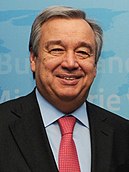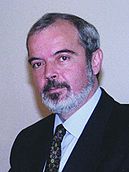Portuguese legislative election, 1995
|
|
|||||||||||||||||||||||||||||||||||||
|---|---|---|---|---|---|---|---|---|---|---|---|---|---|---|---|---|---|---|---|---|---|---|---|---|---|---|---|---|---|---|---|---|---|---|---|---|---|
|
|||||||||||||||||||||||||||||||||||||
|
230 seats to the Portuguese Assembly 116 seats needed for a majority |
|||||||||||||||||||||||||||||||||||||
|
|||||||||||||||||||||||||||||||||||||
|
|||||||||||||||||||||||||||||||||||||
| Portugal |
 This article is part of the series: |
This article is part of the series:
Politics and government of
Portugal
The Portuguese legislative election of 1995 took place on 1 October. The Socialist Party defeated the Social Democratic Party under the lead of António Guterres, elected three years before, but missed the absolute majority by 4 MPs. The Social Democratic party under the lead of Fernando Nogueira was weakened by the end of a ten years cycle of government of Cavaco Silva. The two minor parties, the People's Party and the Democratic Unity Coalition achieved only 15 MPs each, a thing that marked the growing bi-polarization of the Portuguese political map. Although turnout, in percentage point, was lower than the previous election in 1991, almost 6 million voters cast a ballot on election day, the highest figure since 1980.
Voter turnout stood at 66.3%, the lowest till then.
The major parties involved were listed with their leaders:
António Guterres, leader of the Socialist Party, was nominated Prime Minister for the first time, becoming the first socialist Prime Minister in 10 years.
The following table shows the opinion polls of voting intention of the Portuguese voters before the election. Those parties that are listed are currently represented in parliament. Included is also the result of the Portuguese general elections in 1991 and 1995 for reference.
Note, until 2000, the publication of opinion polls in the last week of the campaign was forbidden.
...
Wikipedia


